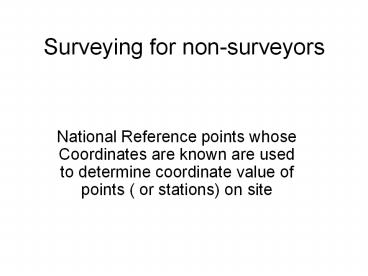Surveying for non-surveyors - PowerPoint PPT Presentation
1 / 21
Title:
Surveying for non-surveyors
Description:
Surveying for non-surveyors National Reference points whose Coordinates are known are used to determine coordinate value of points ( or stations) on site – PowerPoint PPT presentation
Number of Views:112
Avg rating:3.0/5.0
Title: Surveying for non-surveyors
1
Surveying for non-surveyors
- National Reference points whose Coordinates are
known are used to determine coordinate value of
points ( or stations) on site
2
National Reference points connected to site
stations by angular and distance measurement
Site station 1
National Reference point
Site station 2
3
The Coordinates of the site stations are
determined from the angular and distance
measurements
4
The survey measurement can never be without
errors
- So we do calculations to distribute the errors
evenly around all our measurements - In the hope that this will mean smaller errors on
any particular set of coordinates.
5
Angles and distances are measured with an
instrument called a Total Station
- This may be thought of as a particularly
expensive protractor! - The angles can be measured to the 5th decimal
place of accuracy. - The angles in this country are measured in
Degrees, Minutes and seconds. - Distances are measured electromagnetically (i.e.
by light reflection)
6
Consider the angular measurement
360 degrees 1 complete circle
1 Degree 60 Minutes
1Minute 60 Seconds
Also remember that angles can also be measured by
the arc length to radius ratioi.e. Radians
( ? radians 180 degree)
7
To reduce errors angles are measured twice at
each station
- These are known as Face 1 and Face 2 readings----
the average value is used - ( the mean included angle)
- The readings are simply the values pointed to on
the protractor and we need to subtract one
reading from another to determine the angle.
8
Example
First reading 35
Second reading 165
Angle turned through 165 35 130
9
Do not be fooled by these readings!
First reading 335
Second reading 85
Angle turned through 85 335 110
Note when the readings pass through 360 the
subtraction becomes thus 335 to 360 25
PLUS 0 to 85 85 Total angle turned
through 25 85 110
10
The survey usually closes on itself for greater
accuracy
- Hence we can check that the sum of the internal
angles are correct - And distribute around the survey any errors
present.
11
Correcting Angular Errors
- SInternal angles of polygon (2N-4)90
- Dist. Coeff. closing error / N
- Corrected angle Measured angle Dist. Coeff.
- Where closing error Theorectical sum actual
sum of internal angles - N Number of sides or angles in polygon
12
Distance are often also measured several times
- Again the average value is used to help determine
the coordinates of the site stations.
13
Trigonometry
- A recap of your knowledge of trigonometry may be
useful here. - Refer to Trig. File
- This knowledge will be used to determine the
North and East vectors for the distance between
stations - These are known are North and East Partials.
14
Partials
East Partial L x Cos( T)
T
North Partial L x Sin (T)
L
Northings
Eastings
15
Whole Circle Bearings
- The angle used in the Partial calculations is the
angle between the line from station to station
and the North or East axis. - A more general solutions is to use the Whole
Circle Bearing (WCB) of the line. - A WCB is the angle a line makes with the North
Measured in clockwise direction. - Only the WCB of the first line is determined on
site. The rest are calculated from the known
relationship between adjacent lines.
16
Partials from WCB value
WCB
East Partial L x Sin( WCB)
L
North Partial L x Cos (WCB)
Northings
Eastings
NB sin cos different to previous
17
Coordinates
- The coordinates of stations are then calculated
from adjacent stations, starting with the first
known reference point.
Pe
N1
Pn
N2 N1 - Pn
E1
E2 E1 Pe
18
Site Measurement errors
- Of course the coordinates we end up with have
errors and if we do a closed survey ( returning
to the starting point) we will notice that the
coordinates for the end point ( which is in fact
the starting point) do not match the starting
point values the closing error. - We do a correction called the Bowditch correction
to compensate for this.
19
Closing errors
N1
en
N1
Closing error
ee
E1
E1
20
Bowditch Correction
- This suggests that the greater the length of a
measured line the greater the error in
measurement is present. - The amount of correction to a line therefore
depends on its length. The longer the line the
more correction is needed.
21
Formula in Bowditch Correction
- The closing error in the North and East
directions are found first by summing all the
partials. - Correction to Partials
- (Line length / S line lengths) x closing error
in east or north direction - i.e. a fraction x closing error
- the partials are corrected in accordance with
this premise. - The corrected coordinates are then computed.































